Chrisdavetest
On this page, you find all documents, package deals, and flashcards offered by seller chrisdavetest.
- 244
- 0
- 0
Community
- Followers
- Following
1 Reviews received
244 items
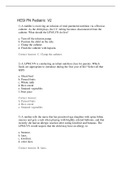
HESI PN PEDS V2
HESI PN Pediatric V2 1) A toddler is receiving an infusion of total parenteral nutrition via a Broviac catheter. As the child plays, the I.V. tubing becomes disconnected from the catheter. What should the LPN/LVN do first? a. Turn off the infusion pump. b. Position the child on the side. c. Clamp the catheter. d. Flush the catheter with heparin. Correct Answer: C. Clamp the catheter. 2) A LPN/LVN is conducting an infant nutrition class for parents. Which foods are appropriate to introd...
- Exam (elaborations)
- • 16 pages •
HESI PN Pediatric V2 1) A toddler is receiving an infusion of total parenteral nutrition via a Broviac catheter. As the child plays, the I.V. tubing becomes disconnected from the catheter. What should the LPN/LVN do first? a. Turn off the infusion pump. b. Position the child on the side. c. Clamp the catheter. d. Flush the catheter with heparin. Correct Answer: C. Clamp the catheter. 2) A LPN/LVN is conducting an infant nutrition class for parents. Which foods are appropriate to introd...
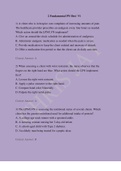
FUNDAMENTALS HESI PN V1
2 Fundamental PN Hesi V1 1) A client who is in hospice care complains of increasing amounts of pain. The healthcare provider prescribes an analgesic every four hours as needed. Which action should the LPN/LVN implement? A. Give an around-the-clock schedule for administration of analgesics. B. Administer analgesic medication as needed when the pain is severe. C. Provide medication to keep the client sedated and unaware of stimuli. D. Offer a medication-free period so that the client can do...
- Exam (elaborations)
- • 20 pages •
2 Fundamental PN Hesi V1 1) A client who is in hospice care complains of increasing amounts of pain. The healthcare provider prescribes an analgesic every four hours as needed. Which action should the LPN/LVN implement? A. Give an around-the-clock schedule for administration of analgesics. B. Administer analgesic medication as needed when the pain is severe. C. Provide medication to keep the client sedated and unaware of stimuli. D. Offer a medication-free period so that the client can do...
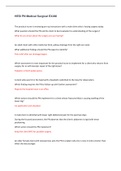
HESI PN Medical Surgical EXAM
HESI PN Medical Surgical EXAM The practical nurse is reviewing pre-op instructions with a male client who is having surgery today. What question should the PN ask the client to best evaluate his understanding of the surgery? What do you know about the surgery you are having? An adult client with otitis media has thick, yellow drainage from the right ear canal. What additional findings should the PN expect to identify? Pain relief after ear drainage begins Which assessment is most importan...
- Exam (elaborations)
- • 8 pages •
HESI PN Medical Surgical EXAM The practical nurse is reviewing pre-op instructions with a male client who is having surgery today. What question should the PN ask the client to best evaluate his understanding of the surgery? What do you know about the surgery you are having? An adult client with otitis media has thick, yellow drainage from the right ear canal. What additional findings should the PN expect to identify? Pain relief after ear drainage begins Which assessment is most importan...
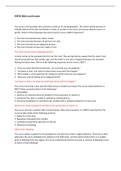
HESI Mid-curricular
HESI Mid-curricular The nurse in the prenatal clinic assesses a client at 31 weeks gestation. The client's blood pressure is 150/96, edema of the face and hands is noted, 3+ protein in the urine, and serum albumin level is 3 gm/dL. Which of the following instructions by the nurse is MOST important? 1. The client should decrease caloric intake. 2. The client should eliminate all salt from her diet. 3. The client should ensure adequate protein. 4. The client should increase her intake of...
- Exam (elaborations)
- • 30 pages •
HESI Mid-curricular The nurse in the prenatal clinic assesses a client at 31 weeks gestation. The client's blood pressure is 150/96, edema of the face and hands is noted, 3+ protein in the urine, and serum albumin level is 3 gm/dL. Which of the following instructions by the nurse is MOST important? 1. The client should decrease caloric intake. 2. The client should eliminate all salt from her diet. 3. The client should ensure adequate protein. 4. The client should increase her intake of...

HESI EXIT COMPREHENSIVE
HESI EXIT COMPREHENSIVE 1.Which information is most concerning to the nurse when caring for an older client with bilateral cataracts? A. States having difficulty with color perception B. Presents with opacity of the lens upon assessment C. Complains of seeing a cobweb-type structure in the visual field D. Reports the need to use a magnifying glass to see small print Rationale: Visualization of a cobweb- or hairnet-type structure is a sign of a retinal detachment, which constitutes a m...
- Exam (elaborations)
- • 47 pages •
HESI EXIT COMPREHENSIVE 1.Which information is most concerning to the nurse when caring for an older client with bilateral cataracts? A. States having difficulty with color perception B. Presents with opacity of the lens upon assessment C. Complains of seeing a cobweb-type structure in the visual field D. Reports the need to use a magnifying glass to see small print Rationale: Visualization of a cobweb- or hairnet-type structure is a sign of a retinal detachment, which constitutes a m...
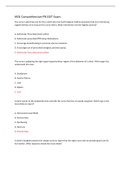
HESI Comprehensive PN EXIT Exam
HESI Comprehensive PN EXIT Exam The nurse is planning care for the a client who has fourth degree midline laceration that occurred during vaginal delivery of an 8 pound 10 ounce infant. What intervention has the highest priority? A. Administer Prescribed stool softner B. Administer prescribed PRN sleep medications. C. Encourage breastfeeding to promote uterine involution D. Encourage use of prescribed analgesic perineal sprays. A. Administer Prescribed stool softner The nurse is palpat...
- Exam (elaborations)
- • 47 pages •
HESI Comprehensive PN EXIT Exam The nurse is planning care for the a client who has fourth degree midline laceration that occurred during vaginal delivery of an 8 pound 10 ounce infant. What intervention has the highest priority? A. Administer Prescribed stool softner B. Administer prescribed PRN sleep medications. C. Encourage breastfeeding to promote uterine involution D. Encourage use of prescribed analgesic perineal sprays. A. Administer Prescribed stool softner The nurse is palpat...
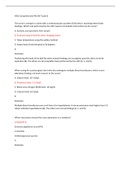
HESI Comprehensive PN EXIT Exam B
HESI Comprehensive PN EXIT Exam B The nurse is caring for a client with a cerebrovascular accident (CVA) who is receiving enteral tube feedings. Which task performed by the UAP requires immediate intervention by the nurse? A. Suctions oral secretions from mouth B. Positions head of bed flat when changing sheets C. Takes temperature using the axillary method D. Keeps head of bed elevated at 30 degrees B Rationale: Positioning the head of the bed flat when enteral feedings are in progres...
- Exam (elaborations)
- • 42 pages •
HESI Comprehensive PN EXIT Exam B The nurse is caring for a client with a cerebrovascular accident (CVA) who is receiving enteral tube feedings. Which task performed by the UAP requires immediate intervention by the nurse? A. Suctions oral secretions from mouth B. Positions head of bed flat when changing sheets C. Takes temperature using the axillary method D. Keeps head of bed elevated at 30 degrees B Rationale: Positioning the head of the bed flat when enteral feedings are in progres...
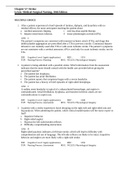
stroke_tb_.rtf
Chapter 57: Stroke Lewis: Medical-Surgical Nursing, 10th Edition MULTIPLE CHOICE 1. After a patient experienced a brief episode of tinnitus, diplopia, and dysarthria with no residual effects, the nurse anticipates teaching the patient about a. cerebral aneurysm clipping. c. oral low-dose aspirin therapy. b. heparin intravenous infusion. d. tissue plasminogen activator (tPA). ANS: C The patient’s symptoms are consistent with transient ischemic attack (TIA), and drugs that inhibit pla...
- Exam (elaborations)
- • 11 pages •
Chapter 57: Stroke Lewis: Medical-Surgical Nursing, 10th Edition MULTIPLE CHOICE 1. After a patient experienced a brief episode of tinnitus, diplopia, and dysarthria with no residual effects, the nurse anticipates teaching the patient about a. cerebral aneurysm clipping. c. oral low-dose aspirin therapy. b. heparin intravenous infusion. d. tissue plasminogen activator (tPA). ANS: C The patient’s symptoms are consistent with transient ischemic attack (TIA), and drugs that inhibit pla...

stroke_noans.docx
1. After a patient experienced a brief episode of tinnitus, diplopia, and dysarthria with no residual effects, the nurse anticipates teaching the patient about a. cerebral aneurysm clipping. b. heparin intravenous infusion. c. oral low-dose aspirin therapy. d. tissue plasminogen activator (tPA). 2. A 68-year-old patient is being admitted with a possible stroke. Which information from the assessment indicates that the nurse should consult with the health care provider before giving the...
- Exam (elaborations)
- • 4 pages •
1. After a patient experienced a brief episode of tinnitus, diplopia, and dysarthria with no residual effects, the nurse anticipates teaching the patient about a. cerebral aneurysm clipping. b. heparin intravenous infusion. c. oral low-dose aspirin therapy. d. tissue plasminogen activator (tPA). 2. A 68-year-old patient is being admitted with a possible stroke. Which information from the assessment indicates that the nurse should consult with the health care provider before giving the...
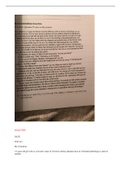
SOLUTION 1
SOLUTION DATE 8:00 am Ms Charlene 14 year old girl who is a known case of Chronic kidney disease due to inherited pathology is alert & awake. Pallor, bilateral pitting edema on lower limbs & facial puffiness is present. Breath sounds are quite normal and respiration is normal. Heart sounds heard normally. Bp 90/60 mmHg. P/R = 80 Spo2 = 98% Dialysis shunt is present in the left forearm. Current mood is unpleasant and with sad facial expressions. Speech out put is reduced. H/o low physi...
- Exam (elaborations)
- • 2 pages •
SOLUTION DATE 8:00 am Ms Charlene 14 year old girl who is a known case of Chronic kidney disease due to inherited pathology is alert & awake. Pallor, bilateral pitting edema on lower limbs & facial puffiness is present. Breath sounds are quite normal and respiration is normal. Heart sounds heard normally. Bp 90/60 mmHg. P/R = 80 Spo2 = 98% Dialysis shunt is present in the left forearm. Current mood is unpleasant and with sad facial expressions. Speech out put is reduced. H/o low physi...

TEST BANK FOR FOUNDATIONS OF MENTAL HEALTH CARE 6TH EDITION BY MORRISON-VALFRE